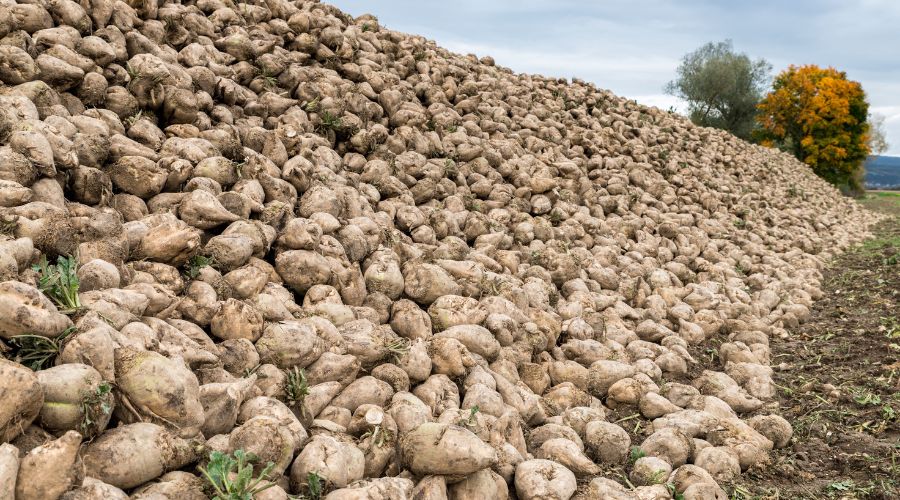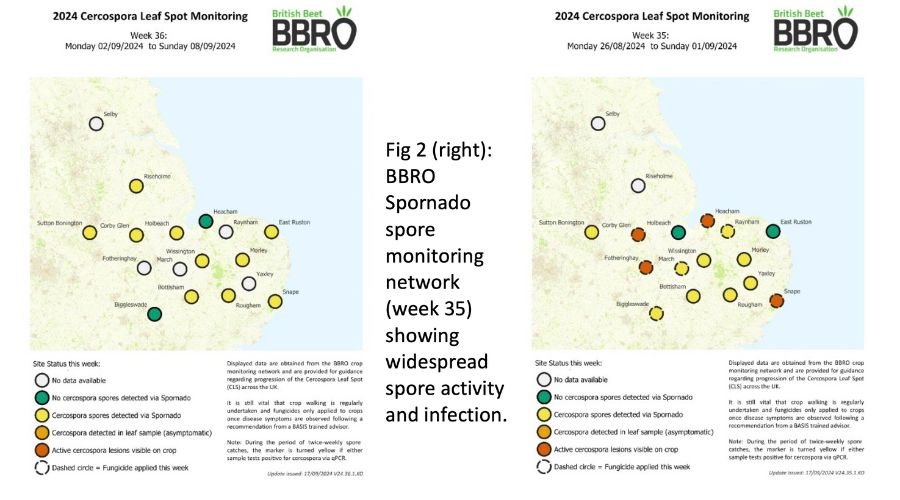Maximise yield and sugar content during harvesting
24th September 2024
BBRO issued an advisory bulletin in mid-September, offering sugar beet growers the following advice to ensure a smooth and more profitable harvest.

Preserving sugar content during harvesting, cleaning and loading is a priority, especially whilst temperatures remain warm. Target optimum crowning, low levels of root damage and bruising, minimal time in clamp, especially large clamps containing large amounts of soil and green material.
To minimise root breakage, avoid running the harvester too aggressively. Assess for root breakage and bruising at the clamp. Check for any over crowning and loss of yield. Use the BBRO ‘Harvesting Assessment Guide’ for assessing losses.
Ensure a regular dialogue between harvester and haulier and avoid leaving large clamps for longer than necessary before delivery, particularly given current temperatures. Avoid too much soil and top in clamps. Avoid leaving large clamps (more than 2m in height) with lots of soil and tops for more than a few days in warm conditions.
Foliar diseases
Incidences of foliar disease are widespread but at a low level.
BBRO’s cercospora monitoring programme is now coming to an end, with the data collected from the spornado monitoring traps providing a clear insight into spore release.
The risk forecast (based on forecasted weather conditions) has only triggered in a few areas, in which cercospora has been found. There have been pockets of cercospora found across the growing region, which may be linked more to local factors.
If you are planning late lifting, you may want to consider a third fungicide to keep your canopy as healthy as possible, making the most of both late sunlight and frost protection.
The latest results from the BBRO Spornado spore monitoring network (week 36) show the areas in which cercospora spores have been captured during the week commencing 2nd September, with no newly developed disease found in crop:

At a recent BeetField event at Yaxley, Cambridgeshire, professor Mark Stevens, head of science and interim head of BBRO, offered the following eight-point plan for autumn disease management:
1. Know what disease(s) are in your crop in order to select the best fungicide options.
2. Cercospora leaf spot appears to be an increasing problem in the UK, and strains of this fungus are potentially resistant (due to Qol resistance) to strobilurin fungicides. If in doubt, contact the BBRO for help with disease identification.
3. As seen from previous BBRO trials, do not apply fungicides too early – wait for early symptoms to show.
4. Conversely, do not apply products too late, otherwise effective disease control will be difficult for the remainder of the season.
5. Always follow label recommendations for applying products at the correct growth stage.
6. Ensure the gap between the first and second, or second and third, applications is kept to within 28 days to prevent significant re-infection occurring between treatments.
7. Ensure water volume recommendations are adhered to and are not cut back.
8. Know where specific varieties are sown within fields to monitor any variety-disease interactions.
The BBRO Plant Clinic is a free service to sugar beet growers, offering an initial response to enquiries within 48 hours. Find more information here.
READ MORE: Sugar beet growers begin harvest for 2024/25 campaign
READ MORE: Two sugar beet factories open as 2024/25 campaign begins
Weed beet and bolters
Keep on top of weed beet and bolters as these have increasingly been seen in crops. One weed beet could produce 1,500 viable seeds, this is of particular concern for anyone using Conviso Smart technology.
One of the key stewardship actions to preserve the longevity of this chemistry is to ensure scrupulous removal of bolters to prevent seed shed and a problem developing where the seed bank becomes contaminated with weed beet tolerant to ALS-chemistry.
Consequently planning, meticulous management and attention to detail is vital – and cost effective for all growers.
- Failure to adequately control ConvisoSmart bolters breeds a new generation of weed beet that cannot be controlled with ALS-chemistry; there are no new technologies currently in development to manage this new problem.
- Begin to identify fields with bolters which will require removal and have a plan/book labour to achieve this in a timely manner.
- The most effective technique is hand-pulling; this is best done when soils are moist and using a fork to help remove the whole plant (including root).
- Ideally plants should be destroyed pre-flowering and removed from the field; snapping the stem close to the base can be an option at this timing, although beware of the potential for re-growth.
- If plants have started to flower, then uprooting bolters and removing from the field is vital to minimise the risk of mature seed being shed.
- Bear in mind fields will need to be walked methodically (e.g. a tramline at a time) and at least twice (min. 3–4-week interval) to try and best ensure all bolters are removed.
READ MORE: Sugar beet campaign 2024: BBRO announces changes to its team
Rotational requirements for Cruiser treated crops
Please remember the following-crop restrictions apply for subsequent crops planted on the same area of land as Cruiser SB sugar beet drilled in 2024.
- Any crop excluded from the below table should be considered ‘restricted’ i.e. a minimum of 32 months from drilling of sugar beet.
- The 32-month restriction applies to those agri-environment options that allow flowers to grow or appear on the same ground on which Cruiser SB treated seed was sown in 2024.
- Cover crops (including mixes) must also follow the 32-month restrictions.
Read more sugar beet articles.
